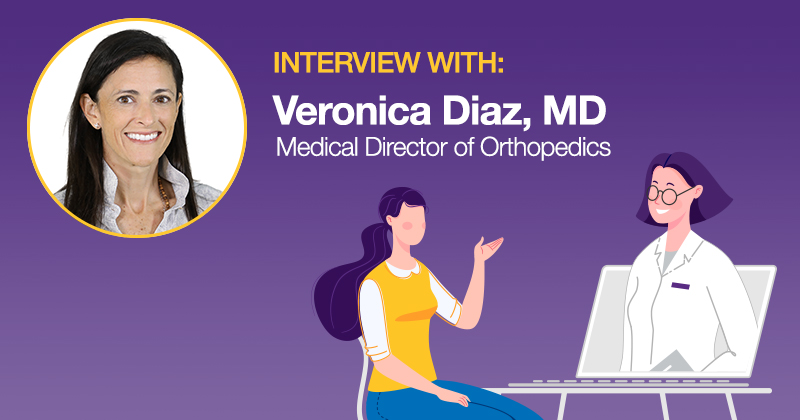Using Orthopedic Telehealth in Your Practice

How orthopedists are using telehealth during the public health emergency.
This blog was published on April 3, 2020, during the public health emergency.
Modernizing Medicine’s story began with a simple conversation with a doctor. That conversation would lead to an idea, a solution, and ultimately, a company. And now, in this extraordinary time we find ourselves in, we are turning to our doctors—both our clients and our on-staff physicians—more than ever. Recently, we sat down with one of those doctors, Dr. Veronica Diaz, to see how practices like hers are using orthopedic telehealth in the wake of the recent public health emergency.
MM: What do you want orthopedists to know about telehealth services?
VD: As of last Monday, many orthopedic practices in this country were forced to close and many patient appointments have been canceled. Telehealth can help physicians and their patients stay connected during this time.
For orthopedics, the use case opportunities are many:
- Checking in with a patient to see how they are responding to physical therapy
- Following up to review imaging results that could inform medical decision-making
- Monitoring postoperative patients
- Following up on the response to an injection
All of these follow-ups could be conducted through telehealth.
MM: How have you been using orthopedic telehealth in your practice?
VD: Because of the need to exercise social distancing, this past week I began seeing patients via telehealth. I saw a patient who had been having trouble regaining hand and finger motion after wrist surgery, and I was able to have a quick telehealth visit with them to confirm that they had recovered the ability to make a full active composite fist. This type of follow-up to assess progress in range of motion is particularly time-sensitive for orthopedic surgery patients.
I saw another patient who had dislocated her shoulder and needed a visit to review the nerve conduction test and check her recovery. I was able to tell her that the test was negative. This was important for her to hear because a nerve injury could have contraindicated certain treatment options, and not knowing was anxiety-provoking for her.
I was also able to speak with a patient who was recovering from a marine-acquired atypical infection that’s being managed by an infectious disease specialist. Just a quick follow up to see what her motion and pain levels were like, whether the swelling had gone down, how she was responding to the prescribed antibiotics.
All of this was made possible by orthopedic telehealth.
MM: Are there some cases where telehealth services should not be used?
VD: Whether orthopedic telehealth should or shouldn’t be used is a decision that should be made at the discretion of the doctor. Patients with acute open injuries, acute fractures or dislocations, suspected compartment syndrome, and suspected or established active infections should be seen in person.
MM: What is it like to be an orthopedic surgeon in the current climate?
VD: Many states are under executive order not to allow elective procedures. We do not want to find ourselves in a situation of resource shortage or depletion as we approach surge capacity to treat critically ill COVID-19 patients. We are forced to come to terms with the fact that performing certain elective, non-essential surgeries is not currently in our best collective interest. Our emergency and critical care colleagues are facing supply shortages. Soon, ambulatory surgical centers may need to be repurposed as overflow intensive care units as the hospitals in epicenters become overwhelmed. This situation also means that many orthopedic practices have lost their revenue stream overnight. Our overhead expenses aren’t going away. We still need to keep up with payroll, lease or mortgage payments, etc. Many of us are worried about the financial impact of this unprecedented public health crisis. Telehealth is a powerful tool to help practices weather this difficult time and let patients know that we are here for them.
MM: Anything else you’d like your fellow orthopedists to know?
VD: We shouldn’t lose sight of the fact that we are all in this together. There are resources out there that can help. Reach out to your societies. The American Academy of Orthopaedic Surgeons and the American Society for Surgery of the Hand have all been very proactive, sending out email blasts that speak to the billing, coding and compliance issues that surround telehealth, and how everything has changed with the recent emergency legislation.
This is a challenging time, certainly unparalleled in my lifetime, but I draw strength from all of the courage being shown by the medical personnel on the frontlines, and by all of the innovation I see in response to the situation.
MM: What did you cover at your recent telehealth webinar?
VD: I went over some technical troubleshooting issues and tried to help practices understand how the modmed Telehealth solution works. There will be a learning curve for practices and patients, and we want them to know that we’re here to help.
At Modernizing Medicine®, we know that telehealth isn’t the answer to everything. But it may be something that helps during this unprecedented public health crisis.
This blog is intended for informational purposes only and does not constitute legal or medical advice. Please consult with your legal counsel and other qualified advisors to ensure compliance with applicable laws, regulations, and standards. It is each provider’s responsibility to determine that any telemedicine visit meets medical necessity for a given patient. Not all clinical scenarios may be appropriate for telemedicine visits, and the provider may need to evaluate the patient in person to establish a diagnosis or initiate treatment.





